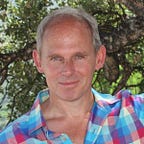Half Earth: Our Planet’s Fight For Life by Edward O. Wilson
I sat in my study thinking about the title of this book; Half Earth: Our Planet’s Fight For Life.
The term “fighting for life” usually refers to a person who has suffered some sort of trauma, a terrible accident or an awful disease. Yet the Earth is fighting for its life because the dominant species on the Earth is ruining it. The Earth is threatened by excess carbon dioxide in the atmosphere, biodiversity loss, plastic and oil pollution, desertification, loss of fertile soil and deforestation. We did all that. No meteorite collision, no massive volcanic eruption, no hostile invasion from outer space. The infinite complexity and the unique ability of Earth to support life are all being put in peril by human recklessness and greed.
That means that it is our duty to fix this. Not just our duty, we have to fix this if we are to have a future. How we might fix this mess is the journey on which Wilson takes us.
Wilson is a biologist and life is at the centre of his work. He explains that the life we see on Earth now is not a random selection of species. Life is like a tree, growing from a simple common seed, splitting, evolving and taking on new forms, new limbs, new branches, finally reaching the twigs and leaves which are the species and individuals alive today. Current species are alive now as they are suited to their environment. Species that thrive in a situation are in a better position to pass on their characteristics to the next generation. That is how evolution works.
No species exists in isolation. Everything needs something created by something else. Trees need carbon dioxide exhaled by mammals, mammals need the oxygen produced by trees. Everything consumes organic matter from plants or flesh. There is a constant consumption, digestion, excretion, recycling and recombining that benefits the whole ecosystem.
Life requires dependencies, life is dependent on the ecosystem. The ecosystem is life.
Wilson writes eloquently on the history and value of ecosystems. No surprise given his background. But there are people with a very different view, who see the current ecological crisis as merely a temporary failure of knowledge as humanity moves to its ultimate goal of controlling the whole planet to our own advantage. Their aim is a singularly human planet, a testament to human ingenuity.
Wilson argues strongly against this view. He sets out the argument that this position is dangerously misguided and arrogant. He is an eminent biologist yet makes it quite clear that he does not understand Earth’s complexity nearly enough to take charge of its systems. Whilst human understanding of ecosystems has progressed immensely, we do not fully understand the interactions between the plants and animals that we know of. Added to that doubt, much of the living world is invisible to science. It simply hasn’t been discovered. There are too many variables, too many things we don’t know, too many species we don’t know. We just don’t understand the full extent of our dependence on ecosystems. We have no idea what we can afford to lose.
In the face of this realisation, the sanest response to try and preserve all that we can. This is the central idea of the book and the basis of its title. Wilson boldly advocates setting aside fully half of the Earth for nature. He goes to great lengths to justify the need to preserve the complexity of nature, and how we cannot hope to tame it, but unfortunately doesn’t really address how this might be achieved. He lists some of the great wild areas of the world (The Redwood Forests of California, The Amazon River Basin, The Cerrado, Lake Baikal) but doesn’t identify how they might be united in a Half-Earth project.
In most discussions about the ecological crisis, what we should do is frequently clear or relatively easy to understand. The devil is always in the detail of “how”. How do we get governments to see these things as important? How do we thwart the intentions of logging, mining and drilling businesses? How do we convince landowners that there are better uses for their land? It would be good to hear Wilson’s views on some of these matters.
This book is a biologist writing about what is most precious to him, life on Earth. It is also a book about his sadness for the damage and madness inflicted on the unique and precious Earth by humans that continually demonstrate how poorly they understand or value the world they have inherited. As Wilson reminds us …
“We are still too greedy, shortsighted and divided into warring tribes to make wise, long-term decisions. Much of the time we behave like a troop of apes quarrelling over a fruit tree”.
If you want to buy the book, using these links helps me keep writing reviews:
